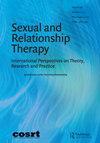通过物化理论评估和理解男同性恋和双性恋男性的身体形象和身体满意度
IF 1.4
4区 心理学
Q3 PSYCHOLOGY, CLINICAL
引用次数: 0
摘要
摘要对顺性女性的身体不满和客体化理论的盛行进行了研究和讨论。关于男同性恋和双性恋群体中身体形象的研究得出结论,要么是一小部分男同性恋和双性恋男性对自己的身体不满意,要么是男同性恋和双性恋男性对自己的身体满意度高于顺性女性。首先,本研究旨在评估未被充分研究的同性恋群体的身体形象和满意度。然后,它旨在了解男同性恋者对身体形象和身体不满的叙述。采用多维身体-自我关系问卷-外表量表(MBSRQ-AS)和客观化身体意识量表(OBCS)组成的独特调查方法,共收集了387份调查问卷,其中包括158名顺性女性和179名男同性恋和双性恋男性。根据初步观察,男同性恋和双性恋男性对身体的满意度要高于顺性女性。然而,当按年龄分组时,16-25岁的男同性恋和双性恋男性对身体的不满程度高于顺性女性,也高于其他年龄段的男同性恋和双性恋男性。这些结果开启了一种对话,即传统上被认为是女性化的经历也会影响到男性化的个体。摘要:这项研究调查了同性恋群体的身体形象和满意度,发现同性恋和双性恋男性通常比顺性女性对身体满意度更高。然而,年龄在16-25岁的年轻男同性恋和双性恋男性对身体的不满程度高于顺性女性和其他年龄段的男同性恋和双性恋男性。这些发现表明,传统的女性经历会影响男性个体。感谢凯利·肯特博士对这项新手研究的指导、启发和培养,帮助我们发掘出一些概念和数据,帮助人们减少对自己经历的羞耻感。谢谢你,艾伦·利普斯科姆博士,没有你,这篇文章就没有机会帮助人们了解男性的经历。披露声明作者未报告潜在的利益冲突。作者声明,没有收到任何资金、赠款或其他支持来开展这项研究,也没有收到任何资金来协助编写本文。作者没有相关的财务或非经济利益要披露。材料准备、数据收集和分析由Brandon Simpson完成。手稿的初稿是由布兰登·辛普森写的,并已批准了最终手稿。数据可用性声明作者确认在文章中可以获得支持本研究结果的数据。作者是研究概念和设计的唯一贡献者。本文章由计算机程序翻译,如有差异,请以英文原文为准。
Assessing and understanding body image and body satisfaction in gay and bisexual men through objectification theory
AbstractBody dissatisfaction and the prevalence of Objectification Theory are researched and often discussed in terms of cisgender women. Research that mentions body image in the gay and bisexual community concludes that there is either a small percentage of gay and bisexual men that experience body dissatisfaction or that gay and bisexual men have higher rates of body satisfaction than cisgender women. This study, firstly, aims to assess body image and satisfaction in the understudied gay community. Then, it aims to develop an understanding of gay men’s narratives of body image and body dissatisfaction. Using a unique survey composed of the Multidimensional Body-Self Relations Questionnaire-Appearance Scale (MBSRQ-AS) and the Objectified Body Consciousness Scale (OBCS), a total of 387 surveys, including 158 cisgender women and 179 gay and bisexual men, were collected. Upon initial observation, gay and bisexual men have greater body satisfaction than cisgender women. However, when grouped by age, gay and bisexual men aged 16-25 have a higher body dissatisfaction than cisgender women and have higher body dissatisfaction than the other age groups of gay and bisexual men. These results start the conversations that experiences that are considered traditionally feminine can affect masculine individuals.LAY SUMMARYThis study examines body image and satisfaction in the gay community, finding that gay and bisexual men generally have higher body satisfaction than cisgender women. However, younger gay and bisexual men aged 16-25 have higher body dissatisfaction than cisgender women and other age groups of gay and bisexual men. These findings suggest that traditionally feminine experiences can impact masculine individuals.Keywords: Body imageobjectification theorygay and bisexual menmbsrq-asoBCS AcknowledgementThank you, Dr. Kelly Kent, for guiding, inspiring, and nurturing this novice research to unearth concepts and data that will help people feel less shame about their experiences. Thank you, Dr. Allen Lipscomb, without you, this piece of literature would not have the opportunity to help shed light on the male experience.Disclosure statementNo potential conflict of interest was reported by the author(s). The author declares that no funds, grants, or other support were received for conducting this study and no funding was received to assist with the preparation of this manuscript. The author has no relevant financial or non-financial interest to disclose. Material preparation, data collection and analysis were performed by Brandon Simpson. The first draft of the manuscript was written by Brandon Simpson and has approved the final manuscript.Data availability statementThe authors confirm that the data supporting the findings of this study are available within the article The author was the sole contributor to the study concept and design.
求助全文
通过发布文献求助,成功后即可免费获取论文全文。
去求助
来源期刊

Sexual and Relationship Therapy
PSYCHOLOGY, CLINICAL-
CiteScore
3.80
自引率
9.10%
发文量
37
期刊介绍:
Sexual and Relationship Therapy is a leading independent journal in its field, well established and internationally recognized. It offers an active, multidisciplinary forum for review and debate across the spectrum of sexual and relationship dysfunctions and therapies. The journal presents original research and best practice and is a vehicle for new theory, methodology, and application. Sexual and Relationship Therapy is edited by a respected international team and publishes contributions from around the world. It is the official journal of the British Association for Sexual and Relationship Therapy (BASRT).
 求助内容:
求助内容: 应助结果提醒方式:
应助结果提醒方式:


